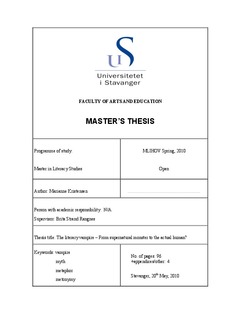| dc.description.abstract | This thesis will be a study of whether there has been a significant shift with regards to how the mythical figure of the vampire is portrayed in literature. Starting with Bram Stoker's Dracula, via Interview with the Vampire by Anne Rice, to the contemporary vampire, illustrated by the Twilight series by Stephenie Meyer and Charlaine Harris' The Southern Vampire Mysteries this thesis seeks to investigate whether these books show a historical development of the figure of the vampire in literature. The thesis takes a theory set forth by Jules Zanger in his essay 'Metaphor into Metonymy: The Vampire Next Door' (1997), as its starting point. Zanger states that the modern vampire has been demythologized, thus, the basic nature of the vampire has evolved so that it has become less metaphorical and more metonymical. Because of this demythologization, we are no longer talking about two separate semantic domains, 'human' and 'supernatural', but just one, 'human' and 'almost human'. Chapter two offers an overview of the theoretical background for this thesis, such as myth and the vampire as myth. The former presents an overview of the concept of myth. The latter shows how the vampire is represented in myths and outlines what the typical characteristics and rules that apply to the mythical figure of the vampire. Next, there is a section that displays the metaphor/metonymy aspect both in general and as used in this thesis. The results of the interpretation and discussion of the books used in this thesis showed that reading the contemporary vampire as more metonymical can be a valid interpretation. The reason why one can say this is because the vampire has definitely become more human over the years. This entire study comes down to the fact that the vampire as a mythical figure, as seen in Dracula, is so fundamentally different from humans that it becomes something awful and frightening. The contemporary vampire, on the other hand, has evolved into being representative of something that is so similar to humans that the prospect of becoming a vampire is not at all threatening anymore; it is actually the way to find your true self. If we view the change in the literary vampire as such, namely as being a way for humans to realize their potential, we see that it is not the figure of the vampire per se that changes and makes the vampire more metonymical. It is, in fact, what the figure of the vampire has to offer us that changes. Therefore, it is the vampire's ability to realize a human's potential that makes reading the vampire as more metonymical and less metaphorical one way of understanding the literary vampire. | en_US |
